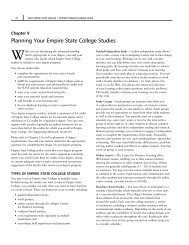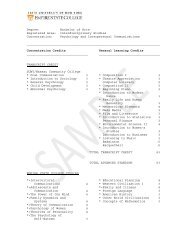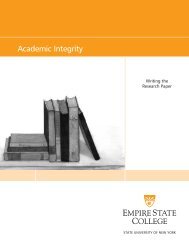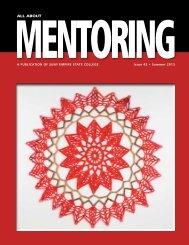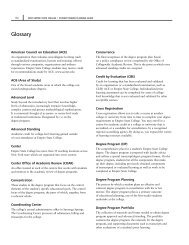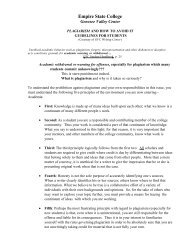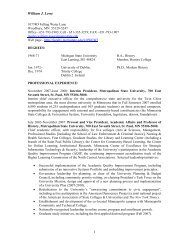All About Mentoring Spring 2011 - SUNY Empire State College
All About Mentoring Spring 2011 - SUNY Empire State College
All About Mentoring Spring 2011 - SUNY Empire State College
Create successful ePaper yourself
Turn your PDF publications into a flip-book with our unique Google optimized e-Paper software.
9<br />
support, caregivers being in actual control of<br />
the children’s daily life, and having a group<br />
goal that drives the war or conflict.<br />
How Art Supports Children<br />
in War Zones<br />
Drawings from the Spanish Civil War (1936-<br />
1939) to the present, a period of over 70<br />
years, show that through the visual arts,<br />
children illustrate and bring meaning to their<br />
experience of war. The act of drawing taps<br />
imagination, which is a vital developmental<br />
expression and tool throughout childhood<br />
that helps support the child’s effort to make<br />
sense of the world in which she lives and<br />
her place in it. It can be of particular value<br />
to children as they try to make sense of<br />
their experience of living in a war zone. In<br />
addition to artwork providing a means for<br />
finding comfort and achieving a level of<br />
understanding of the catastrophe of war, it<br />
can provide a means for the child to express<br />
inner turmoil and explore ways to cope with<br />
threats to her psychological well-being. How<br />
does this work<br />
First, child art achieves self expression and<br />
its components: emotional release and a<br />
sense of one’s individuality. Second, child<br />
art can provide a means of coping through<br />
mental exploration of imagined solutions to<br />
extremely threatening events.<br />
Self Expression and Affirmation<br />
of Individuality<br />
An important characteristic of child art is<br />
that it is not tied to language. A child can<br />
express confusion and fear nonverbally.<br />
Huxley (1939) writes of drawings by those<br />
evacuated to the safety of children’s camps<br />
during the Spanish Civil War (1936-1939):<br />
“Their drawings are more eloquent than<br />
their words, better than their syntax (n.p.).”<br />
Of Sudanese child refugees, the Associazione<br />
Volontari per il Servizio Internazionale<br />
(AVSI) (1998) reported that drawing was<br />
part of the recovery process: “The words<br />
and drawings flow from what is uppermost<br />
in their minds; they receive no direction<br />
(n.p.).”<br />
The child’s psychological needs for<br />
emotional release and affirmation of<br />
individuality are given little room during<br />
the chaos of war when avoiding danger<br />
and meeting basic physical needs demand<br />
intense attention from both children and<br />
adults. Child artwork offers a possibility<br />
for meeting these two psychological needs.<br />
It can offer emotional release, for example,<br />
by locating fear in a dreaded object such as<br />
a monster, creating frightened self portraits,<br />
or by depicting explosions and destruction.<br />
It can affirm individuality by providing a<br />
means for the creation of one’s own unique<br />
personal world on paper, preserving a sense<br />
of self, of being “me,” the person of action,<br />
who makes the picture.<br />
In the early 1940s, Jewish children deported<br />
to the World War II concentration camp<br />
Terezin, northwest of Prague, drew over<br />
7,000 pictures under the direction of a<br />
fellow inmate, the artist and teacher Friedl<br />
Dicker-Brandeis. Milton (2001) addresses<br />
the way in which such child artwork was<br />
able to alleviate the constant awareness<br />
of adults and children that their lives<br />
were under the complete control of their<br />
captors. She argues that in Terezin, Dicker-<br />
Brandeis used art as an outlet for children’s<br />
imaginations and as an escape “enabling<br />
them to gain control of their own personal<br />
space and time” (p. 30). That is, controlling<br />
a part of one’s life, what one draws, shows<br />
children that they remain vital and capable,<br />
an alternative perception to the reality of<br />
having all aspects of their lives determined<br />
by the enemy in charge of the concentration<br />
camp. These children were provided<br />
moments of freedom to explore themselves<br />
and their inner world. They also signed<br />
their artwork, which recognized agency, the<br />
exercise of individual will, of being effective<br />
in having an impact on the material world.<br />
Mental Exploration<br />
With art materials, children can re-envision<br />
their world in ways that portray timeseparated<br />
events and confusing experiences.<br />
For example, drawings can combine<br />
elements of the child’s life before war with<br />
life under attack. Drawing 1 showed a<br />
transitional moment: a peaceful town under<br />
aerial attack, mothers walking holding a<br />
child’s hand, two wounded or dead among<br />
the neat buildings, one building shattered, a<br />
child covering her eyes. It is an illustration<br />
of the child selecting elements that are<br />
incongruent, in this case, peace and aerial<br />
attacks, which can form a step in meaningmaking<br />
by first portraying the incongruency.<br />
This makes available to the child the<br />
discordant elements which had disturbed her<br />
understanding of what she perceived.<br />
Children also can depict imagined scenes of<br />
defeating the enemy. Two drawings from the<br />
Spanish Civil War collection demonstrate<br />
this approach. In Drawing 13, the enemy<br />
portrayed as an animal is actually leashed<br />
and under a child’s control. In Drawing 15,<br />
enemy airplanes are targeted. These uses<br />
of art for mental exploration illustrate the<br />
potential value to the child of a preferred<br />
personal story, explanation or wish. This<br />
can be soothing to a threatened child.<br />
Children’s war drawings selected for this<br />
paper illustrate the clear ability of children<br />
to depict what they see and recall, create<br />
visual representations of their war-based<br />
fears, and use the medium as an ally in their<br />
effort to use their minds and imagination to<br />
envision and cope with the atrocities that<br />
they have witnessed.<br />
References<br />
Apfel, R. J., & Simm, B. (1996). Minefields<br />
in their hearts: The mental health of<br />
children in war and communal violence.<br />
New Haven, CT: Yale.<br />
Associazione Volontari Per Il Servizio<br />
Internazionale (AVSI) et al. (1998).<br />
Where is my home Children in war.<br />
Kampala: AVSI: Gulu Support the<br />
Children Organisation (GUSCO): Red<br />
Barnet: United Nations Children’s Fund<br />
(UNICEF): World Vision.<br />
Fox, C. (2001, Dec. 16). Artist gave hope to<br />
children during Holocaust, Visual Arts<br />
Review. Retrieved from http://www.<br />
jewishatlanta.org/page.aspxid=26053<br />
Gangi, J.M., and Barowsky, E. (2009,<br />
August). Listening to children’s voices:<br />
Literature and the arts as means<br />
of responding to the effects of war,<br />
terrorism, and disaster. Childhood<br />
Education, 85(6), 357-364.<br />
Huxley, A. (1939). Introduction, They still<br />
draw pictures. Southworth Spanish<br />
Civil War Collection, Mandeville<br />
Special Collections Library, University<br />
of California, San Diego. Retrieved<br />
from http://orpheus.ucsd.edu/speccoll/<br />
tsdp/<br />
suny empire state college • all about mentoring • issue 39 • spring <strong>2011</strong>




